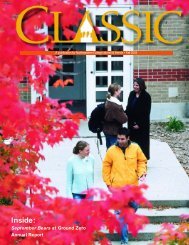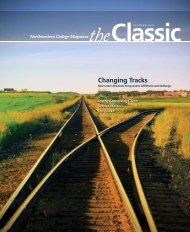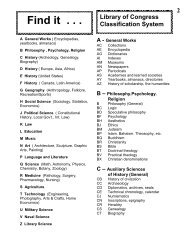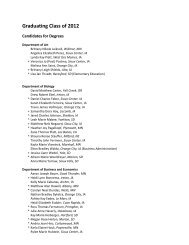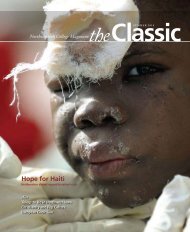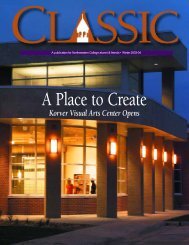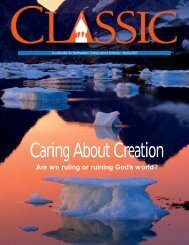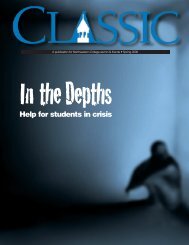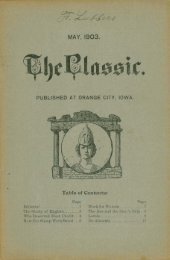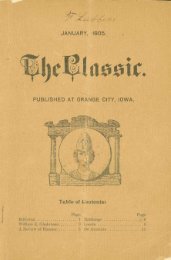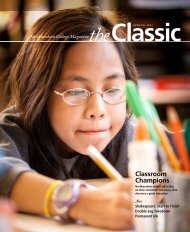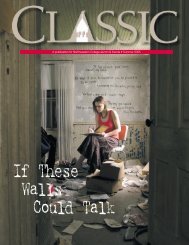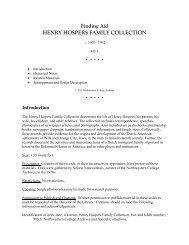Summer 2007 - Northwestern College
Summer 2007 - Northwestern College
Summer 2007 - Northwestern College
You also want an ePaper? Increase the reach of your titles
YUMPU automatically turns print PDFs into web optimized ePapers that Google loves.
<strong>Northwestern</strong> Classic<br />
Alumniprofile<br />
Asian longhorn beetle<br />
A childhood fascination with insects led<br />
Kelley Downer to a career studying<br />
invasive species that threaten agricultural<br />
and forest systems.<br />
mucus, fungus and eggs into<br />
pine trees. In a year’s time,<br />
the tree dies and the offspring<br />
hatch and feed on the<br />
fungus, posing a serious<br />
threat to the timber industry.<br />
Next winter, Downer hopes<br />
to travel to South Africa,<br />
where, in addition to<br />
Australia and South America,<br />
this woodwasp has caused<br />
significant damage.<br />
A published scientist<br />
with a wide research background,<br />
Downer knows<br />
when to put aside affections<br />
for the cute to keep her task<br />
in clear focus: “That’s what I<br />
find really exciting about<br />
insect science: being able to<br />
apply the knowledge learned<br />
about the mechanisms of<br />
basic biology in order to<br />
improve the quality of life<br />
[for humans],” she writes.<br />
<strong>Northwestern</strong> biology<br />
professor Dr. Laurie Furlong<br />
won Downer over to entomology.<br />
During the summers<br />
of 2002 and 2003, with<br />
funding from NWC research<br />
Velvet mite<br />
grants, they traveled to<br />
California’s Santa Cruz Island<br />
to study aquatic insect drift<br />
patterns. The two women<br />
collected insects in a stream<br />
at night, armed with pots<br />
and pans to scare off the wild<br />
boar that visited and snorted<br />
at them in the dark.<br />
Not until Downer<br />
reached graduate school at<br />
the University of Massachusetts<br />
would she realize how<br />
unusual it was to have someone<br />
like Furlong as a mentor—a<br />
woman in the field of<br />
entomology and a Christian.<br />
“There is a general stigma<br />
in the scientific community<br />
that if you believe in<br />
God you obviously cannot<br />
do good science,” Downer<br />
says. “You know there are<br />
others out there who believe<br />
in God and share similar religious<br />
views, but you just<br />
don’t talk about it at work or<br />
in public.”<br />
This June, Downer married<br />
fellow biologist Joshua<br />
Zylstra ’05, bringing to the<br />
partnership an unusual<br />
dowry—a cat, a colony of<br />
giant cave cockroaches and<br />
10 darkling beetles. (Even as<br />
a city kid growing up near<br />
downtown Chicago, she’d<br />
choose bugs for pets; she’d<br />
drip water onto webs, sparing<br />
spiders the need to travel<br />
for a drink.)<br />
And though she donated<br />
her first pinned insect collection<br />
to <strong>Northwestern</strong>’s biology<br />
department, Downer took<br />
her groom’s “I do” as tacit<br />
acceptance of her current<br />
collection of some 100 specimens.<br />
Her collection is ever<br />
expanding thanks to the<br />
“Insect Wish List,” a feature<br />
on her blog where she provides<br />
guidelines for interested<br />
parties to send dead specimens<br />
by mail. A bridal registry,<br />
of sorts.<br />
Forget Fear Factor,<br />
Downer says to the squeamish,<br />
referring to the reality<br />
television show that features<br />
stunts often involving insects.<br />
Bugs are creepy and crawly<br />
for functional reasons, and<br />
we can’t live without them.<br />
It’s often that first bee sting<br />
or the sight of flies on trash<br />
that leads us to associate<br />
bugs with things unpleasant<br />
and dirty; those plagues of<br />
locusts you heard about in<br />
Sunday school are troublesome<br />
too. But the good that<br />
insects do, Downer says, far<br />
outweighs the bad.<br />
“We would be very<br />
much out of luck without<br />
insects carrying about their<br />
daily routines as pollinators<br />
of most of our crops and<br />
plants or decomposers of<br />
decaying animal and plant<br />
matter,” Downer says.<br />
“Insects serve as food for<br />
many animals and even<br />
many human cultures, past<br />
and present. We need<br />
insects, despite whatever<br />
fears they evoke in us.”<br />
Downer is out to change<br />
that fear to fascination. Take<br />
a caddisfly, she says, mentioning<br />
a photo in her blog.<br />
It collects debris and builds a<br />
protective case on its back—<br />
“its own little mobile<br />
home”—and casts a silk net<br />
to catch algae floating by—“a<br />
little garden.” Cute, huh?<br />
No matter where she<br />
is—at a microscope, near a<br />
stream, in a forest of pine<br />
trees in upstate New York—<br />
Downer finds herself full of<br />
wonder.<br />
Longhorn beetle pupa<br />
“As an entomologist, I’m<br />
amazed by those who can<br />
witness the incredible diversity<br />
of species, spectacular<br />
color variations and body<br />
forms, and uniquely bizarre<br />
behaviors of the insect world<br />
and attribute their existence<br />
to pure random chance. I<br />
can’t help but stand in awe of<br />
a creative God’s handiwork.<br />
“It’s like a present every<br />
time I look under a microscope.”<br />
A cute, little present.<br />
Kelley Downer<br />
27 ▲ <strong>Summer</strong> <strong>2007</strong>



